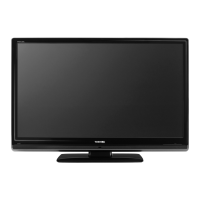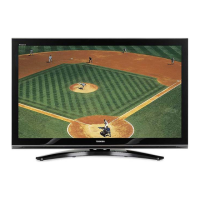
Do you have a question about the Toshiba 46RV525RZ and is the answer not in the manual?
| Screen Size | 46 inches |
|---|---|
| Resolution | 1920 x 1080 |
| Display Type | LCD |
| Aspect Ratio | 16:9 |
| Contrast Ratio | 50000:1 (Dynamic) |
| Brightness | 500 cd/m2 |
| Response Time | 8 ms |
| HDMI Ports | 3 |
| USB Ports | 1 |
| Component Video Inputs | 2 |
| Composite Video Inputs | 1 |
| Viewing Angle | 178° |
| VGA Port | 1 |
| RF Input | 1 |
| Power Consumption | 220W |
| Composite Video Input | 1 |
| Dimensions (W x H x D) | 295 mm |
Section for recording the TV's model and serial number for future reference.
Critical safety warnings for fire, shock, and physical injury.
Recommendations for safe placement and use around children.
Detailed safety guidelines for operation and installation.
Recommendations for proper installation and placement.
Steps for attaching the TV to its base stand.
Instructions for safely mounting the TV to a wall.
Specifications for VESA mounting hole patterns.
Statement regarding compliance with FCC Part 15 rules for digital devices.
Information on technical limitations and common visual symptoms.
Overview of key features and technologies of the LCD television.
A step-by-step guide to setting up and using the TV.
Identification and function of physical buttons and ports on the TV.
Diagram and explanation of rear panel input/output terminals.
Description of common cables for connecting audio/video devices.
Instructions for connecting VCR, antenna, or cable box to the TV.
Guide for connecting component video devices like DVD players or receivers.
Steps for connecting devices via HDMI or DVI inputs.
How to connect and control compatible devices via HDMI.
Instructions for connecting external audio systems for better sound.
Guide to connecting a PC via PC IN or HDMI terminals for display.
Instructions for installing batteries and understanding remote setup.
Optimal usage distance and aiming for the remote control.
Explanation of the functions of various remote control buttons.
How to program the TV remote to operate other devices.
Table showing key functions across different modes (TV, Cable, VCR, DVD).
Step-by-step process to program the remote for external devices.
Codes for various brands of cable boxes, satellite receivers, and DVD players.
Visual guide to the main TV menu structure and options.
Structure of the Installation and System Status submenus.
How to use buttons to move through and select menu options.
Configuring power saving modes and on-screen display language.
Option to turn the TOSHIBA logo indicator light on or off.
Setting the TV to receive signals via antenna or cable.
Automatic and manual processes for storing TV channels.
Assigning custom names or logos to channels for easier identification.
Configuring audio output settings for HDMI inputs.
Checking signal strength and system information.
Adjusting time zone and restoring factory settings.
How to choose which connected device's signal to display.
Customizing names for connected input devices.
Using the browser for channel navigation and selection.
Creating and managing a list of favorite channels.
Configuring browser lists and navigating through them.
Selecting channels directly from the Channel Browser.
Adding, clearing, and managing the list of recently viewed items.
Choosing between Standard, Auto, or Digital tuning for channels.
Navigating programmed channels and directly tuning.
Using Channel Return and SurfLock™ for quick channel switching.
Adjusting the display aspect ratio for different program formats.
Adjusting the viewable area for letterbox programs.
Automatically adjusting picture size based on input signal.
Optimizing picture for DVD playback with 3:2 pulldown.
Pausing the live TV picture.
Accessing and modifying picture quality parameters.
Fine-tuning contrast, brightness, color, tint, and sharpness.
Enabling and configuring on-screen caption displays.
Customizing digital caption appearance and selecting caption services.
Turning the TV audio on or off using the MUTE button.
Choosing between stereo, mono, or second audio program (SAP) audio.
Modifying bass, treble, and balance for desired sound.
Configuring the format for digital audio output.
Adjusting audio compression for ATSC broadcasts.
Accessing parental controls and security features.
Setting up or modifying the TV's PIN for security features.
Setting parental controls based on program content ratings.
Adding external rating systems for enhanced parental controls.
Preventing access to selected TV channels.
Restricting access to specific video input sources.
Setting a time limit for gaming sessions, activating input lock.
Disabling physical TV buttons to prevent unauthorized changes.
Adjusting image parameters when a PC is connected.
Configuring audio output for PC connections.
Scheduling the TV to turn off automatically after a set time.
Enabling control of connected Toshiba devices via HDMI.
Controlling playback devices like DVD players using the TV remote.
Adjusting volume and muting audio from a connected receiver.
Features like auto input switching and device standby.
How the TV automatically turns off after inactivity.
How the TV remembers settings after power loss.
Fine-tuning picture quality with contrast, gamma, and color.
Automatically adjusting contrast based on picture content.
Adjusting black levels for picture detail.
Reducing visible interference in analog or noisy video signals.
Reducing interference caused by MPEG compression.
Reducing input lag for video games.
Customizing sound effects and audio processing.
Enabling 3D positional sound effects.
Basic checks for common operational and setup issues.
Diagnosing issues with image quality, signal reception, and display.
Resolving static, snow, or problems with selecting video sources.
Addressing poor color, sync, or composite/S-Video picture problems.
Troubleshooting audio-video sync discrepancies.
Troubleshooting audio issues like no sound or incorrect audio.
Problems with remote operation and channel scanning.
Troubleshooting caption display, parental controls, and device linking.
Resolving problems related to HDMI cable and source connectivity.
Detailed technical specifications of the TV model.
Supported resolution and frequency formats for PC and HDMI inputs.
Terms and conditions of the US warranty for LCD TVs.
Terms and conditions of the Canadian warranty for flat panel TVs.
Legal disclaimers and limitations on warranty claims.
Procedures for resolving disputes and warranty claims.
Restrictions on using the TV for life-support or critical systems.












